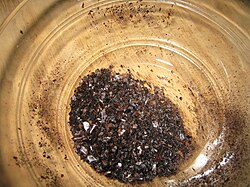 | |
| Type | Dried food |
|---|---|
| Place of origin | Oman, Iraq and Iran |
| Region or state | Middle East |
| Associated cuisine | Middle Eastern cuisine |

Dried lime, also known as black lime, [1] noomi basra (Iraq), [2] limoo amani (Iran), and loomi (Oman), [3] is a lime that has lost its water content, usually after having spent a majority of its drying time in the sun. They are used whole, sliced, or ground as a spice in Middle Eastern cuisine. Originating in the Persian Gulf [4] [5] – hence the Iranian name limoo amani and the Iraqi name noomi basra ('lemon from Basra') – dried limes are popular in cookery across the Middle East.